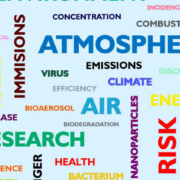Nanoparticles
Nanoparticles (NP), particles that are roughly 1-100 nm in size, can be directly emitted into the atmosphere from primary sources or be formed in the atmosphere through nucleation of gas-phase species. NP can be divided into natural and anthropogenic particles and anthropogenic NP can be either inadvertently formed as a by-product, mostly during combustion, or produced intentionally due to their particular characteristics, in the latter case referred to as engineered or manufactured NP.
Primary emitted anthropogenic NP have attracted a lot of attention in the last years because of the increasing production of engineered NP in nanotechnology and nanoindustry. Today, nanoscale materials find use in a variety of different areas such as electronic, biomedical, pharmaceutical, cosmetic, energy, environmental, catalytic and material applications.
Because of the forecasted huge increase in the manufacture and use of engineered nanomaterials in industrial and household applications, human and environmental exposure to NP is likely increasing and the concern about the possibility of adverse health effects of NP has become a top priority in governments, the private sector and the public all over the world.


Several research studies aim to better understand occurrence, fate and effects of nanoparticles in the environment, both manufactured and unintentionally produced. Compared to conventional or other emerging pollutants, nanoparticles pose some new challenges for scientists. Whereas it is already obvious that particle size plays an important role with respect to toxicity, less is known how size affects the behavior and reactivity of nanoparticles. Moreover, the surface of NP can be modified by environmental factors (light, oxidants, coatings or microorganisms) thus affecting the release of NP into the environment, their properties and behavior. These are important processes, which have to be further investigated also with the development of appropriate analytical instruments.


We are interested to contribute in the field of nanoparticle studies by proposing, designing and implementing innovative technical solutions, improved systems and new applications for:
- NP monitoring and sampling
- NP source emission characterization
- NP concentration levels and fate
- NP health effects and personal exposure assessment







